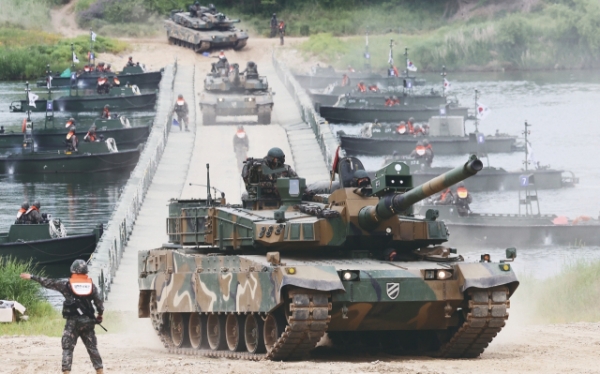
Since the Korean Armistice Agreement of 1953, Korea has remained divided into two separate states for more than seven decades. Despite the ceasefire, military tensions have persisted, leading both sides to engage in an arms race. While North Korea has focused most of its resources on developing nuclear weapons, South Korea has advanced in the production of conventional weapons, such as tanks, missiles, and aircraft. As a result, South Korea’s arms and defense industry has grown significantly, enabling the country to emerge as a global exporter of military equipment.
In 2022, South Korea’s defense exports reached a peak of USD 17.3 billion, including a USD 12.4 billion mega-deal with Poland. The Polish government agreed to purchase the Chunmoo rocket system, K2 Black Panther tanks, K9 Thunder self-propelled howitzers, and other equipment from Hanwha Aerospace and Hyundai Rotem. The agreement included 288 Chunmoo rockets, 672 K9 Thunder howitzers, and 1,000 K2 Black Panther tanks. To date, contracts have been signed for 218 Chunmoo rockets, 364 K9 Thunders, and 180 K2 tanks, with the second phase of the contract ongoing for the remaining weapons.
Although exports decreased to USD 13 billion in 2023, the number of countries interested in South Korean defense equipment tripled, rising from four to twelve. Furthermore, the variety of export items doubled, reflecting a diversification of defense exports. Earlier this year, Saudi Arabia finalized a USD 3.2 billion deal with LIG Nex1, another Korean arms and defense firm, to purchase ten Cheongung-II missile systems. The Cheongung-II is an upgraded medium-range surface-to-air missile (M-SAM) system, an improved version of the previous Cheongung-I. Saudi Arabia is now the second Middle Eastern country, after the United Arab Emirates, to acquire the Cheongung-II system.
Korean defense exports continued to expand this summer when Romania signed an agreement with Hanwha Aerospace to buy 54 K9 Thunders and 36 K10 ammunition resupply vehicles. Hanwha Aerospace is set to deliver the armaments by 2027. With these successes, South Korea has entered the ranks of the top ten arms exporters globally. As Korean weapons gain popularity worldwide and constitute a significant portion of the country’s GDP, the South Korean government has announced its goal of becoming the fourth-largest arms exporter by 2027.
The success of Korean weaponry can be attributed to its top-tier performance, cost-effectiveness, and high productivity. South Korean arms are fully capable of competing with the best weapons from the U.S., Germany, and other developed nations. For instance, in March 2024, ten NATO member nations participated in the Dragon 24 exercise as part of the Steadfast Defender 24 operation. Each country brought its main battle tanks, such as the Leopard 2 from Germany and the Abrams from the U.S., while Poland used the K2PL (a modified version of the K2). During the shooting test, the K2PL demonstrated over 90% accuracy, outperforming all other main battle tanks in the driving test as well. In addition to their capabilities, Korean weapons offer a price advantage over Western alternatives. For example, the K2 Black Panther tank costs nearly half the price of comparable Western main battle tanks. Lastly, Korean defense companies can deliver weapons incomparably quick. For example, Hyundai Rotem made a contract with Poland to deliver 180 K2 tanks in 3 years, while Germany said they could only send about one tank per month.
Additional reasons for the sudden boom of K-defense are the on-going wars around the world. After the Ukraine war broke out in 2022, many European countries realized the need to reinforce their military. As a result, they searched for the best partner to import weapons, and Korea happened to be the perfect option for several countries. Meanwhile, the tension in the Middle East also worsens the global situation and yields countries to rearm.
Korea’s defense industry has rapidly grown into a global powerhouse, and it is expected to be one of the key industries of Korea in the near future. With the government’s ambitious goal of becoming the fourth-largest arms exporter by 2027, South Korea is poised to play an even more significant role in the global defense market, reflecting its rise as both an economic and military force.


